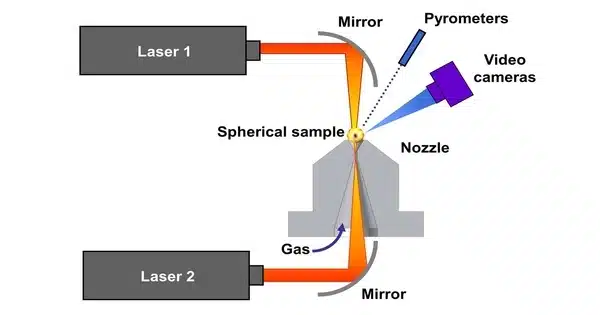Aerodynamic levitation, also known as aerodynamic suspension or aerodynamic levitation, is a technique for suspending objects in mid-air by using aerodynamic forces. The use of gas pressure to levitate materials so that they are no longer in physical contact with any container is known as aerodynamic levitation. This eliminates contamination and nucleation issues associated with physical contact with a container in scientific experiments. It is based on fluid dynamics principles and uses the pressure difference between the object and the surrounding fluid to achieve levitation.
A fluid, such as a gas or a liquid, is used to create a cushion of air or another fluid medium on which the object can float in aerodynamic levitation. It is possible to defy gravity and keep an object suspended in mid-air by controlling the flow of fluid and manipulating the pressure distribution around the object.
Overview
Many objects that use gas pressure to counteract gravity and allow stable levitation could be classified as aerodynamic levitation. Helicopters and air hockey pucks are two examples of aerodynamically levitated objects. However, this term is now also associated with a scientific technique that employs a cone-shaped nozzle to enable stable levitation of 1-3mm diameter spherical samples without the use of active control mechanisms.
It’s worth noting that “aerodynamic levitation” can also refer to a technique known as “aerodynamic levitation melting,” which is used to melt and solidify materials without the use of a container. This method is widely used in materials research and the manufacture of specialized alloys and glasses.
Application
Aerodynamic levitation is commonly used in wind tunnels and aerodynamic testing facilities. Aerodynamic forces generated by the airflow in the wind tunnel can be used to suspend models of aircraft, automobiles, and other objects in the air. This allows researchers and engineers to study the object’s aerodynamic properties without interference from ground effects.
Aerodynamic levitation is used in a variety of other fields, including materials science and metallurgy. It is possible to study a sample’s properties under controlled conditions, such as high temperatures or the absence of gravitational forces, by levitating it using aerodynamic forces. This method is especially useful for studying materials with high melting points or those that react with container materials.
Advances in technology and computational fluid dynamics have enabled more precise control and manipulation of aerodynamic forces in recent years, making aerodynamic levitation more versatile and accurate in its applications.















